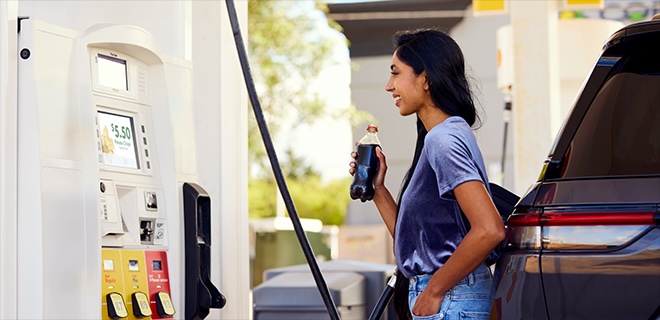
The IAB’s recent launch of a Digital Out of Home (DOOH) working group and release of the IAB definition of DOOH signals a significant milestone in DOOH’s evolution. As more marketers look toward digital solutions, it’s time for DOOH to step out of the shadows of its traditional predecessors and claim its rightful place in the digital ecosystem.
Today, DOOH has advanced beyond a digital version of static signage. It’s now an integrated platform that combines the best of all worlds—targeting, context, performance, measurement, and scale.
It’s time for DOOH to stand behind the capital “D” in digital.
Where We’ve Been: DOOH’s Evolution
When people think of DOOH, they often picture billboards—just updated with screens instead of static signage. Historically, billboards were about location, with marketers placing signs in high-traffic areas to maximize visibility. “Exit 1-mile ahead“ or iconic Sunset Boulevard is often the use case.
That mindset hasn’t completely changed. Look at the top outdoor spenders—many are still buying airport placements to reach business decision-makers or purchasing premium locations in trendy neighborhoods to build brand reputation and perceptual scale. These buyers aren’t necessarily looking for performance or data; they focus on physical placement.
That’s how the media industry has thought about out-of-home (OOH) media for decades—dots on a map. DOOH began similarly, with signs that became screens, which now add creative flexibility but little else. The true potential lies in DOOH’s ability to be audience-led, context-driven, and data-rich. When marketers think of all other digital media, they think about targeting, personalization, and attribution. This is how DOOH should evolve to be an integral part of digital media – from living room to handheld to consumer journey to cash register and back again.
DOOH is in good company in this need to retire old silos and legacy assumptions. Amazon has been our favorite e-commerce platform for years and now brings us Thursday night NFL games. NBC was our favorite must-see TV prime-time partner, and now, it has shoppable ad units and advanced audience targeting across its ecosystem. iHeart is the country’s largest radio platform and now brings us live experiences and leading podcasts with individual addressability.
Rethinking old habits and coloring outside the traditional boundaries is where publishers and advertisers can find innovation and efficiencies. DOOH is perhaps the largest innovation opportunity that’s been hiding in plain sight.
Where We Are: The Best of All Worlds
DOOH has matured into a medium that now speaks the same language as other digital channels like CTV and mobile. Every screen in a DOOH network is now addressable, meaning brands can target specific audiences in specific locations at precise moments. This evolution offers buyers the best of all worlds—the scale of linear television, the targeting and measurement of digital media, and the physical presence and real-world context of mobile and OOH. With video, DOOH offers the engagement potential of broadcast, allowing it to deliver a holistic media and creative experience.
This transition represents a shift for DOOH, especially considering the growing recognition of digital traders. They’re not simply looking to place ads on signs, whether digital or static, the way many have used the medium for the past 100 years. Instead, they’re seeking platforms that can connect with audiences in real-world environments and drive measurable actions. T-Mobile’s recent agreement to acquire Vistar Media exemplifies the belief in the power and opportunity of DOOH in omnichannel plans as we look to the future of DOOH.
Where We’re Going: The Opportunity for DOOH
Advertisers today care about reaching the right audience at the right time and place to drive genuine attention and convert that into measurable actions. DOOH—especially with video—is uniquely positioned to do that. Whether it’s dining at a restaurant after seeing an ad or making an immediate purchase, DOOH reaches consumers at moments of high receptivity.
To reach its full potential, DOOH needs to take a page from the evolution of video. The power dynamic in video shifted as digital marketers grew up in a digital-first world and began driving media strategy. Digital muscle memory continues to trigger a change in the world of advertising. CTV and addressable media are smarter executions of legacy TV strategy.
Streaming audio and podcasting are smarter executions of terrestrial radio. Commerce media is a much bigger way to think about shopper and trade marketing, where brand and performance are inextricably linked objectives, and all media investment is held accountable for driving growth. Much like the evolution of these other channels, it’s time for DOOH to make audience, context, and outcomes the core conversation of contemporary DOOH planning.
DOOH Behind the Capital D
DOOH’s next big leap will happen in 2025. Consumers respond differently to media in the physical world, whether in Times Square or on their weekly grocery run. If CTV represents a new way to think about TV, from media selection to consumer engagement to campaign outcomes, DOOH represents a new way to think about OOH.
The size and location of a DOOH screen are only a few elements of why it may be valuable. The audience viewing that screen and their mindset, behaviors, attention, travel, proximity, preferences, and ultimately, purchasing are all possible to consider with DOOH. Now is the time to embrace capital D “Digital” thinking and fully integrate DOOH into omnichannel video, providing advertisers with the closer connection to consumer attention they’ve been seeking.